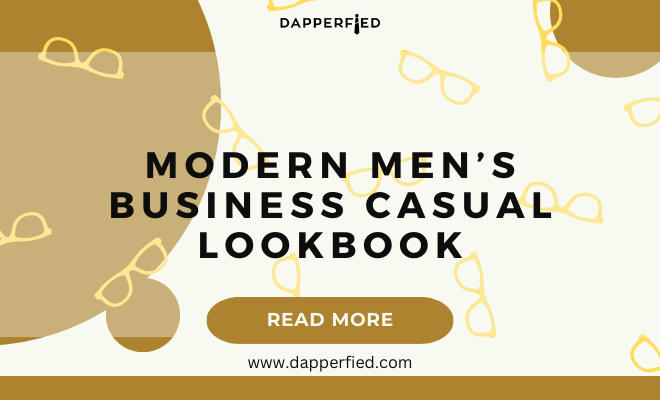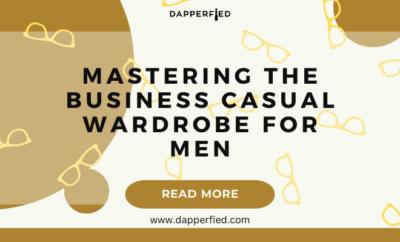
Men's Style
Modern Men’s Business Casual Lookbook
Men’s business casual attire has evolved significantly over the years, reflecting changes in workplace culture and fashion trends. In the past, business casual for men typically meant khaki pants and a polo shirt, but today, the definition has expanded to include a wider range of clothing options. This shift can be attributed to a more relaxed approach to work attire, as well as a desire for greater individual expression in the workplace.
One of the key factors driving the evolution of men’s business casual is the rise of tech and creative industries, which have brought a more casual and laid-back vibe to the workplace. As a result, traditional suits and ties have given way to more relaxed and comfortable clothing choices. Additionally, the influence of social media and the rise of the “influencer” culture has led to a greater emphasis on personal style and self-expression, prompting men to experiment with different looks and push the boundaries of traditional business attire.
Key Takeaways
- Men’s business casual has evolved from traditional suits to a more relaxed and versatile style, allowing for more individual expression and comfort in the workplace.
- Key pieces for a modern business casual wardrobe include tailored chinos, a well-fitted blazer, a variety of button-up shirts, and versatile shoes like loafers or brogues.
- Mixing and matching business casual pieces allows for endless outfit combinations, creating a polished and put-together look for any occasion.
- Incorporating color and patterns into business casual looks can add personality and interest to an outfit, but it’s important to balance bold choices with more neutral pieces.
- Accessorizing with items like a leather belt, a classic watch, and a stylish briefcase or tote can elevate a business casual look and add a touch of sophistication.
- Different business casual environments may call for varying levels of formality, so it’s important to consider the dress code of the workplace and dress accordingly.
- To maintain a modern business casual style, it’s important to invest in quality pieces, pay attention to fit and tailoring, and stay updated on current trends while still maintaining a professional appearance.
Key Pieces for a Modern Business Casual Wardrobe
Building a modern business casual wardrobe requires a mix of classic and contemporary pieces that strike the perfect balance between professionalism and comfort. Key pieces for a modern business casual wardrobe include tailored chinos, slim-fit dress shirts, versatile blazers, and stylish loafers or brogues. These items form the foundation of a versatile wardrobe that can be mixed and matched to create a variety of polished looks.
In addition to these staples, modern business casual attire also includes more casual elements such as well-fitted jeans, knit sweaters, and stylish sneakers. These pieces add a contemporary edge to traditional business attire, allowing men to express their personal style while still looking professional. When building a modern business casual wardrobe, it’s important to invest in high-quality, versatile pieces that can be dressed up or down depending on the occasion.
How to Mix and Match Business Casual Pieces
Mixing and matching business casual pieces is key to creating a stylish and versatile wardrobe. One way to achieve this is by pairing tailored chinos with a crisp dress shirt and a blazer for a polished yet relaxed look. For a more casual vibe, swap the dress shirt for a knit sweater and the blazer for a denim jacket. Mixing different textures and fabrics can also add visual interest to an outfit, such as pairing a wool blazer with a cotton dress shirt or a leather belt with suede loafers.
Another way to mix and match business casual pieces is by experimenting with different color combinations. For example, pairing navy chinos with a light blue dress shirt and a camel blazer creates a classic and sophisticated look. Alternatively, mixing earth tones like olive green and tan can add a modern twist to traditional business casual attire. Ultimately, the key to successful mixing and matching is to find a balance between classic and contemporary elements while staying true to your personal style.
Incorporating Color and Patterns into Business Casual Looks
| Category | Metrics |
|---|---|
| Color | Number of different colors used in an outfit |
| Patterns | Types of patterns incorporated (e.g. stripes, polka dots, plaid) |
| Outfit Balance | How well the colors and patterns complement each other |
| Professionalism | Impact of color and patterns on the overall professional appearance |
Incorporating color and patterns into business casual looks is a great way to add personality and flair to your outfits. When it comes to color, classic neutrals like navy, grey, and beige are timeless choices that exude sophistication and versatility. However, don’t be afraid to experiment with bolder hues like burgundy, emerald green, or mustard yellow to inject some vibrancy into your wardrobe. When incorporating patterns, subtle options like pinstripes, checks, or houndstooth can add visual interest without being too overwhelming.
For a modern twist on business casual attire, consider mixing different patterns and colors to create unexpected combinations. For example, pairing a striped dress shirt with a patterned tie or layering a plaid blazer over a solid-colored shirt can add depth and dimension to your look. Additionally, incorporating accessories like pocket squares or patterned socks can be an easy way to introduce color and pattern into your outfits without overpowering the overall look.
Accessorizing for a Polished Business Casual Look
Accessorizing is an essential part of creating a polished business casual look. A well-chosen belt can add a finishing touch to an outfit, while a stylish watch can elevate your overall appearance. When it comes to footwear, investing in quality leather loafers or brogues is essential for completing a polished business casual look. Additionally, adding a tie or pocket square can instantly elevate your outfit from casual to sophisticated.
Another key accessory for men’s business casual attire is the briefcase or messenger bag. Opt for a sleek leather option in a classic color like black or brown to complement your outfit while providing functionality. Finally, don’t underestimate the power of grooming and personal care as accessories. A well-groomed appearance, including neatly trimmed hair and clean nails, can make a significant difference in how professional and put-together you appear in a business casual setting.
Dressing for Different Business Casual Environments

Dressing for different business casual environments requires an understanding of the specific dress codes and expectations of each setting. In more traditional corporate environments, it’s best to stick to classic business casual pieces like tailored chinos, dress shirts, blazers, and leather shoes. Avoid overly casual items like jeans or sneakers unless explicitly stated in the dress code.
For creative or tech-focused workplaces, there’s often more flexibility in terms of dress code. In these environments, you can experiment with more casual elements like denim jackets, knit sweaters, and stylish sneakers while still maintaining a polished appearance. It’s important to observe the dress habits of your colleagues and take cues from senior management to ensure that your outfit aligns with the company culture.
Tips for Maintaining a Modern Business Casual Style
Maintaining a modern business casual style requires attention to detail and an understanding of how to adapt your wardrobe to different occasions. One tip for maintaining a modern business casual style is to invest in high-quality, versatile pieces that can be mixed and matched to create different looks. This includes well-fitted dress shirts, tailored chinos, and classic blazers that can be dressed up or down depending on the occasion.
Another tip is to pay attention to grooming and personal care. Keeping your hair neatly styled, maintaining good hygiene, and paying attention to small details like ironing your clothes can make a big difference in how professional you appear in a business casual setting. Finally, staying up-to-date with current fashion trends and incorporating them into your wardrobe in subtle ways can help you maintain a modern and stylish business casual look.

In conclusion, men’s business casual attire has evolved significantly over the years, reflecting changes in workplace culture and fashion trends. Building a modern business casual wardrobe requires a mix of classic and contemporary pieces that strike the perfect balance between professionalism and comfort. Mixing and matching business casual pieces is key to creating a stylish and versatile wardrobe, while incorporating color and patterns can add personality and flair to your outfits. Accessorizing is an essential part of creating a polished business casual look, and dressing for different business casual environments requires an understanding of specific dress codes and expectations. Finally, maintaining a modern business casual style requires attention to detail, grooming, and staying up-to-date with current fashion trends.
Looking to elevate your business casual look? Check out our Business Casual Lookbook for men, featuring essential style tips and outfit ideas. And if you’re looking to complete your look with the perfect pair of shoes, be sure to read our article on men’s fashion shoes tips for expert advice on choosing the right footwear. Plus, don’t forget to accessorize with a stylish watch – learn all about picking the right watch in our informative guide here. And if you’re in need of a new suit to round out your wardrobe, be sure to read our article on the vital aspects of buying men’s suits online here.
FAQs
What is a business casual dress code for men?
Business casual for men typically includes a collared shirt, dress slacks or chinos, and dress shoes. Ties are usually optional, and jackets can be added for a more formal look.
What are some examples of business casual outfits for men?
Examples of business casual outfits for men include a button-down shirt with chinos and loafers, a polo shirt with dress slacks and oxford shoes, or a sweater with tailored trousers and brogues.
Can men wear jeans in a business casual setting?
In some business casual settings, men may be allowed to wear dark, well-fitted jeans. However, it’s important to check the specific dress code of the workplace or event to ensure that jeans are appropriate.
What kind of shoes are appropriate for a business casual look for men?
Appropriate shoes for a business casual look for men include loafers, oxfords, brogues, and dress boots. It’s important to choose shoes that are clean, polished, and in good condition.
Are accessories important for a business casual look for men?
Accessories can add a polished touch to a business casual look for men. Consider adding a leather belt, a watch, and possibly a pocket square or tie for a more formal touch. However, it’s important not to overdo it with accessories in a business casual setting.














